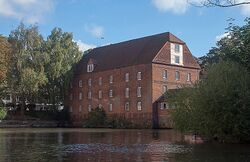History:Town Mill, Guildford
| Town Mill, Guildford | |
|---|---|
 | |
| Type | Watermill |
| Location | Guildford |
| Coordinates | [ ⚑ ] : 51°14′02″N 0°34′29″W / 51.23387°N 0.574848°W |
| OS grid reference | SU9959649263 |
| Area | Surrey |
| Built | 1768, extended 1852 |
| Governing body | Yvonne Arnaud Theatre |
| Owner | Guildford Borough Council |
Listed Building – Grade II | |
| Official name | Town Mill |
| Designated | 1 May 1953 |
| Reference no. | 1188091 |
| Lua error in Module:Location_map at line 522: Unable to find the specified location map definition: "Module:Location map/data/Surrey" does not exist. | |
The Town Mill is a Grade II listed 18th Century watermill located in the centre of Guildford on the River Wey.[1]
History
The earliest recorded mill on the site was one constructed by Walter de la Poyle in 1295. This was a fulling mill as Guildford was an important location in the wool trade. This was probably the mill known as Kings Mill.[2] By the late 17th century the mill had been extended to include corn milling with 4 pairs of stones, two for flour and two for animal feed. The whole assembly was driven by three external water wheels. The construction of the Wey Navigation was a boon for the mill, enabling grain to be delivered to the mill by barge and the resulting sacks of flour to be taken, again by barge, to London.[3]
By 1768 the buildings had become rather dilapidated and the eastern range was demolished and replaced by a three-storey red brick edifice with dentil moulding under the eaves of a tiled roof.[2] The western range was simply repaired and continued in use. This section was known as the Hogsmeat Mill. At the same time the old undershot wheels were replaced with more efficient breast shot wheels. In 1852 the western section was replaced with an identical brick building styled to match the 1768 building. In 1827 it was reported that an extension to the Hogsmeat Mill was attached to the Guildford foundry, on the site now occupied by the Yvonne Arnaud Theatre, but this building was demolished by 1852.[3]
From 1770, an additional water wheel was being used to pump water to the town reservoir on Pewsey Down.[4] This was replaced by two water turbines in 1896, then a single turbine in 1930, in use until 1952 when it was itself replaced by electric pumps nearby. In 2003, Guildford Borough Council arranged for the refurbishment and installation of an identical turbine as an example of renewable energy. Rather than pumping water, this turbine drives a generator to supply up to 260,000 kWH of electricity into the National Grid, annually.[4] The turbine came on-line in 2006.[5] The 1930 turbine has since been preserved, and is on display at Dapdune Wharf.[4]
The Mill is now used by the adjacent Yvonne Arnaud Theatre as a scenery workshop and studio theatre.[3]
References
- ↑ Historic England. "Town Mill, Guildford (1188091)". National Heritage List for England. https://HistoricEngland.org.uk/listing/the-list/list-entry/1188091. Retrieved 28 February 2018.
- ↑ 2.0 2.1 Hillier, Jack (1951). Old Surrey Watermills. London: Skeffington. pp. 106-109.
- ↑ 3.0 3.1 3.2 Stidder, Derek (1990). Watermills of Surrey. Buckingham: Barracuda Books. pp. 78-79. ISBN 0 86023 480 0.
- ↑ 4.0 4.1 4.2 "Hydro Tour Information Sheet". http://www.guildford.gov.uk/NR/rdonlyres/9B9980FE-7332-423B-8922-B0B6DBBF6777/0/HydroTourInformationSheet.pdf. Retrieved 4 April 2008.
- ↑ "Guildford Borough Council wins "green" award for commitment to renewable energy for the hydro project". Government Office for the South East. 13 November 2006. http://www.go-se.gov.uk/gose/news/newsarchive/467693/. Retrieved 4 April 2008.

